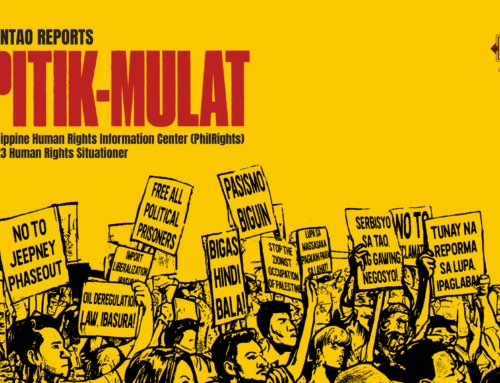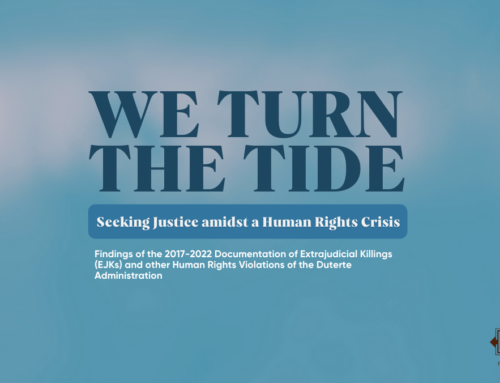 When President Benigno Aquino III took the reins of power in 2010, he was not amiss in pointing out the incongruent actions of his predecessor, Gloria Macapagal-Arroyo. He harped on the previous administration’s failures by stating figures of rice shortage and GMA’s importation of more than seven times the amount of the shortage in 2004 and more than three times the amount of shortage in 2007. He likewise deplored the fact that the excess rice stored in warehouses ended up rotting.1
When President Benigno Aquino III took the reins of power in 2010, he was not amiss in pointing out the incongruent actions of his predecessor, Gloria Macapagal-Arroyo. He harped on the previous administration’s failures by stating figures of rice shortage and GMA’s importation of more than seven times the amount of the shortage in 2004 and more than three times the amount of shortage in 2007. He likewise deplored the fact that the excess rice stored in warehouses ended up rotting.1
In 2011, President Aquino reiterated this criticism of over-importation, which he called the culture of wang-wang in agriculture, citing that before he came to office in 2010, “the Philippines imported 2.3 million metric tons of rice, which was already a million metric tons more than the 1.3 million that we needed.” 2
He then boasted of the achievement of his administration, highlighting that the in a span of one year, the rice shortage immensely decreased. He noted that the estimated yearly shortage of 1.3 million metric tons was brought down to 660,000 or almost half of the original amount. According to him this was due to the use of the “most effective types of seedlings, and careful and efficient spending on irrigation”, resulting in a 15.6 percent increase in rice production.3
It was during this time that the president articulated his vision for rice production in the country. “
 Achieving rice self-sufficiency through FSSR
Achieving rice self-sufficiency through FSSR
Acting on the anomalous reality that an agricultural country like the Philippines has to rely on rice imports to address the people’s needs, the Aquino administration launched the Food Staples Self-sufficiency Roadmap (FSSR) 2011-2016. The program aims to achieve rice self-sufficiency for the country by 2013 and maintain it through the last year of Aquino’s government in 2016.
To achieve self-sufficiency, the FSSR outlined the following strategies:5
1. Increase and sustain the gains in production through production interventions and enabling mechanisms — specifically by producing more than 21.11 and 22.49 million tons of palay by end of 2013 and 2016, respectively. This will involve the corresponding interventions:
Development and maintenance of irrigation systems. The National Irrigation Administration (NIA) will implement projects that will increase irrigation-serviceable areas.
Increase farmers’ access to high quality seeds. Community seed banks (CSB) will be established in cooperation with private seed growers in each province. PhilRice will continue to supply breeder and foundation seeds, while the Bureau of Plant Industry (BPI) will expedite seed certification process. The Land Bank will provide credit assistance to seed growers.
R&D and Promotion of Appropriate Technologies. PhilRice will continue to conduct research and development of rice production technologies; the Bureau of Soil and Water Management (BSWM) will promote balanced fertilization; while the National Organic Agriculture Board will promote sustainable farming systems in areas with low use of inorganic fertilizer.
Development of Upland Rice-Based Farming Systems to address food insecurity of poor households in upland marginal areas.
Extension and Farmers Education. The Agricultural Training Institute will coordinate efforts to build the capacity of rice farmers through community organizing, training and electronic extension [e-Learning].
Enabling mechanisms, to stimulate production response from farmers: (a) NFA reforms, such as increased percentage of domestic palay procurement, phased increase in selling price of rice, CCT in lieu of a direct consumer price subsidy, and focused role on buffer stocking and price support to farmers; (b) increase in credit guarantee fund; (c) greater coverage of crop insurance; and (d) safeguard irrigated rice areas from land conversion.
2. Farm mechanization and reduction of post-harvest losses reduction, which accounts for 16.47% of loss in production. Therefore, the FSSR seeks to
Improve the mechanization level of rice production in the country. Registered participant farmer associations willing to enter in a MOA under a counter-parting scheme are to send farmer-members to training for operating and maintenance of the equipment or facility.
Provide multi-purpose drying pavement, modified MPDP, and flatbed dryers to eligible farmer associations.
The modernization of rice mills. This entails the provision of village-type rice mill (double-pass or more modern type of milling system) to farmer associations through a counter-parting scheme, or of multi-pass rice mills for private millers/traders through loans.
3. Manage consumption by maintaining per capita rice consumption at 120 kg/year.
The DA will partner with other government agencies and NGOs to promote
The consumption of unpolished or brown rice
Reduction of table wastes. Table wastes account for approximately 3 tbsp/day or 14 g/day in raw form. If 94 million Filipinos waste this much every day, the total rice wastage would amount to 480,000 tons of milled rice in a year — enough to feed 4 million people for one year.
Diversifying of staples by increasing production of non-rice staples by 3.5% annually. Encouraging the production of white corn, sweet potato, cassava and plantain can increase their supply and market availability and lower their prices.
Ambitious targets
The Department of Agriculture’s FSSR received much support from farmers, rice and non-rice farmers alike, including NGO advocates on organic farming.
In particular, the Task Force on Rice and Other Staples supports the FSSR’s national development goal. However, it deems the target of achieving rice self-sufficiency by 2013 as “overly optimistic”, seeing 2016 as a more reasonable target but premised on a “palay production growth of 7.10% per annum as against the historical growth rate of 3.4% per annum.”6
The Philippine Institute for Development studies likewise see the target of zero rice imports by 2013 as not feasible. PIDS Senior Research Fellow Roehlano M. Briones, in a Pulong Saliksikan at PIDS, explained that rice self-sufficiency is still untenable and that the Food Staples Sufficiency Program (FSSP) targets are rather ambitious given the country’s rice production record. 7
PIDS points out that “data from the FSSP showed that from 2011 to 2015, palay yield should increase from 3.78 to 4.53 tons per hectare while production should increase from 17 million tons to 22.7 million tons per year. As such, this scenario entails a yearly growth rate of 3.8 percent in yield and 6.3 percent in production to attain rice self-sufficiency. However, past records showed an average growth rate of only 1.5 percent for yield and 3.2 percent for production from 1994 to 2010.” 8
“Since the start of the plan period in 2010, we can already observe deviations from the target. Palay production in 2011 fell short by 2.8 percent. Imports were held to just 0.7 million tons in 2011 and 0.5 million tons in 2012, but this does not mean domestic production is becoming sufficient to meet local demand,” Briones said.9
According to the PIDS, imports will remain high as consumption increases by about 3.4 percent per year due to high population growth rate. Meanwhile, the FSSP assumes a fixed per capita consumption. This results in an underestimation of the amount of palay harvest required to eliminate imports. 10
Apart from this, a number of challenges hinder the country’s goal of achieving rice self-sufficiency. PIDS enumerates these as:
“First, the per capita demand for staples will continue to rise with the country’s rapidly increasing population. This means that farmers need to feed more people than in the
previous years. This task is made more difficult by an increasingly fragile resource base.
Second, the presence of new agricultural technologies and modern tools does not guarantee increased productivity. Adoption by farmers is critical. This would take time, effort, and resources, which — to begin with — are already not sufficient or available to everyone.
Third, the capacity of public institutions working in the rice sector needs strengthening. This calls for more resources and innovative strategies that address farmers’ needs, including working more closely with farmers’ organizations and the private sector. Exploring new approaches to deliver extension, credit, insurance, and other services is recommended.”11
Inadequacies of the FSSP
Advocates and experts acknowledge that in the Philippine setting, the crucial factors for food sufficiency are infrastructure measures (irrigation, post harvest facilities) and other so-called productivity enhancing programs as well as research and development.12 These factors are somehow addressed by the government’s FSSR.
However, experts also point to the need to address the role of the producers, the rice farmers and farm workers. In his paper, Philippine Rice Program: Why is the Philippines, an archipelago endowed with abundant natural and human resources, not self-sufficient in food?, Omi Royandoyan asks: “Are their rights, property rights and means of production secured to fully participate in production activities? Or do they engage in production simply to survive, to support their family or to maintain their socio-economic condition?” 13
Royandoyan asserts that any rice program or production sufficiency related program that does not take into consideration the property rights or land ownership of producers will not succeed. He highlights the importance of productivity enhancing programs, which should go together with the land ownership issue, the means of production. Unfortunately, the infrastructure and property rights (or the equity and growth issue) nexus was not adequately included in the rice self-sufficiency program.
“Growth without equity is meaningless. Likewise, equity without growth is not sustainable. It is evident that infrastructure support is inadequate to raise rice production,” 14says Royandoyan.
According to him, the lack of credit, insurance and marketing support likewise limits the productive capacity of rice farmers. More often, this aspect is hardly recognized as critical to addressing food sufficiency. But the truth is, marketing and credit support programs make affordable and timely resources accessible to farmers. They go hand in hand with land ownership and land productivity. Control of the rice industry is primarily determined by whoever controls the marketing–trading enterprise. Hence, direct support to rice farmers must be an utmost priority for the success of any rice program.
Royandoyan’s paper also points to irrigated lands at risk to climate change as another critical factor in rice production.
Citing reconstructed data on irrigated lands at risk to climate change by former Bureau of Soil and Water Management (BSWM) Director Roger Concepcion, Royandoyan notes that 2.32 million hectares of potentially irrigable areas (or 74.52%) are at risk.15
The highest risk from climate change are Luzon irrigated lands, which are prone to crop failures brought on by excess rainfall and high temperatures (rainfall variability), serious damage to standing crops and infrastructures (incidence of super typhoons), deep and prolonged floods and landslides, and increasing temperature and extreme dryness during dry months. 16
Missing the Target
The FSSR aimed to achieve 21.11 and 22.49 million tons of palay by end of 2013 and 2016. When the government set these goals, some quarters doubted the feasibility of these targets as mentioned above.
True enough, only 18.58 million metric tons is projected to be produced by end of 2013. Reports attribute the government’s readjustment of its timetable for the sufficiency target to the series of natural disasters such as typhoon Haiyan, locally named “Yolanda.” 17
Thus in 2014, the government is targeting to produce 19.32 million metric tons (MMT), way below its 21.11 MMT original target for 2013.
Poverty and Hunger
While the Aquino government’s goal of rice self-sufficiency is laudable, despite its seemingly unfeasible targets and consequently its failure to achieve the targets, the hunger and poverty situation of the country has not significantly improved.
In 2012, poverty incidence was at 22.3%. Though this is lower than the 22.9% poverty incidence posted in 2009, the rate of reduction is substantially no different from 2006, which pegged the poverty incidence at 23.4%. 18
Also, in a survey conducted by the Social Weather Stations (SWS) in the second quarter of 2013, the number of Filipino families who experienced having nothing to eat at least once rose by one million. From 19.2 percent or an estimated 3.9 million in March, hunger incidence rose to 22.7 percent (or an estimated 4.9 million in June).19
“Moderate hunger, which refers to those who experienced having nothing to eat “only once” or “a few times” in the last three months, increased to 17.3 percent (around 3.7 million families) from 15.6 percent (3.2 million) in March.”20
By the third quarter, the number of families experiencing involuntary hunger at least once in the past three months decreased by 17.9% (or an estimated 3.9 million families). 21However, this was almost the same number of families who experienced involuntary hunger in March of 2013, revealing that for this year, involuntary hunger affected almost the same number of families and that there is no substantial decrease in the hunger situation.
The figures are most likely to shoot up in the succeeding hunger surveys, because the one done in the third quarter of the year was conducted prior to the onslaught of super typhoon Yolanda that devastated most of central Philippines.
No significant change in poverty and hunger amidst less rice imports
It is apparent that in 2013, the government has failed to remarkably improve the poverty and hunger situation in the country. Though the country imported less rice during the current administration compared to the Arroyo government, this did not statistically translate to significantly less hunger and poverty.
Also, the government failed to reach the target rice self-sufficiency in 2013, primarily because these did not truly reflect the realities on the ground and the increasing demand for food.
Furthermore, the government needs to go beyond these targets and its identified strategies and instead adequately address the concerns of rice producers regarding property rights and the means of production, marketing, credit and support services as well as the challenges of climate change.
The right to food is a basic human right that the State has the obligation to respect, promote and fulfill. Rice self-sufficiency is a step towards the realization of this right. However, this must translate to a reduction in poverty incidence and the number of people suffering from hunger. Unfortunately, this was not the case in 2013.








